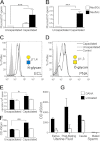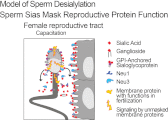Sialidases on mammalian sperm mediate deciduous sialylation during capacitation
- PMID: 22989879
- PMCID: PMC3488077
- DOI: 10.1074/jbc.M112.380584
Sialidases on mammalian sperm mediate deciduous sialylation during capacitation
Abstract
Sialic acids (Sias) mediate many biological functions, including molecular recognition during development, immune response, and fertilization. A Sia-rich glycocalyx coats the surface of sperm, allowing them to survive as allogeneic cells in the female reproductive tract despite female immunity. During capacitation, sperm lose a fraction of their Sias. We quantified shed Sia monosaccharides released from capacitated sperm and measured sperm sialidase activity. We report the presence of two sialidases (neuraminidases Neu1 and Neu3) on mammalian sperm. These are themselves shed from sperm during capacitation. Inhibiting sialidase activity interferes with sperm binding to the zona pellucida of the ovum. A survey of human sperm samples for the presence of sialidases NEU1 and NEU3 identified a lack of one or both sialidases in sperm of some male idiopathic infertility cases. The results contribute new insights into the dynamic remodeling of the sperm glycocalyx prior to fertilization.
Figures





Similar articles
-
Mice carrying two t haplotypes: sperm populations with reduced Zona pellucida binding are deficient in capacitation.Biol Reprod. 1999 Jul;61(1):305-11. doi: 10.1095/biolreprod61.1.305. Biol Reprod. 1999. PMID: 10377063
-
Analysis of chaperone proteins associated with human spermatozoa during capacitation.Mol Hum Reprod. 2007 Sep;13(9):605-13. doi: 10.1093/molehr/gam043. Epub 2007 Jun 26. Mol Hum Reprod. 2007. PMID: 17595329
-
The roles of protein disulphide isomerase family A, member 3 (ERp57) and surface thiol/disulphide exchange in human spermatozoa-zona pellucida binding.Hum Reprod. 2017 Apr 1;32(4):733-742. doi: 10.1093/humrep/dex007. Hum Reprod. 2017. PMID: 28175305
-
Epididymal protein CRISP1 plays different roles during the fertilization process.J Androl. 2011 Nov-Dec;32(6):672-8. doi: 10.2164/jandrol.110.012922. Epub 2011 Mar 25. J Androl. 2011. PMID: 21441424 Review.
-
Sialylation: fate decision of mammalian sperm development, fertilization, and male fertility†.Biol Reprod. 2023 Aug 10;109(2):137-155. doi: 10.1093/biolre/ioad067. Biol Reprod. 2023. PMID: 37379321 Review.
Cited by
-
Identification and Partial Characterization of Two Populations of Prostasomes by a Combination of Dynamic Light Scattering and Proteomic Analysis.J Membr Biol. 2015 Dec;248(6):991-1004. doi: 10.1007/s00232-015-9810-0. Epub 2015 Jun 12. J Membr Biol. 2015. PMID: 26065901
-
Glycans - the third revolution in evolution.Front Genet. 2014 May 23;5:145. doi: 10.3389/fgene.2014.00145. eCollection 2014. Front Genet. 2014. PMID: 24904645 Free PMC article.
-
Artificial Polysialic Acid Chains as Sialidase-Resistant Molecular-Anchors to Accumulate Particles on Neutrophil Extracellular Traps.Front Immunol. 2017 Sep 29;8:1229. doi: 10.3389/fimmu.2017.01229. eCollection 2017. Front Immunol. 2017. PMID: 29033944 Free PMC article.
-
Sialylation of Asparagine 612 Inhibits Aconitase Activity during Mouse Sperm Capacitation; a Possible Mechanism for the Switch from Oxidative Phosphorylation to Glycolysis.Mol Cell Proteomics. 2020 Nov;19(11):1860-1875. doi: 10.1074/mcp.RA120.002109. Epub 2020 Aug 24. Mol Cell Proteomics. 2020. PMID: 32839225 Free PMC article.
-
Desialylation of Spermatozoa and Epithelial Cell Glycocalyx Is a Consequence of Bacterial Infection of the Epididymis.J Biol Chem. 2016 Aug 19;291(34):17717-26. doi: 10.1074/jbc.M116.718072. Epub 2016 Jun 23. J Biol Chem. 2016. PMID: 27339898 Free PMC article.
References
-
- Varki A., Schauer R. (2009) Essentials of Glycobiology, pp. 199–218, Cold Spring Harbor Press, Plainview, NY - PubMed
-
- Schröter S., Osterhoff C., McArdle W., Ivell R. (1999) The glycocalyx of the sperm surface. Hum. Reprod. Update 5, 302–313 - PubMed
-
- Schauer R. (1982) Chemistry, metabolism, and biological functions of sialic acids. Adv. Carbohydr. Chem. Biochem. 40, 131–234 - PubMed
-
- Schauer R. (2004) Sialic acids: fascinating sugars in higher animals and man. Zoology 107, 49–64 - PubMed
-
- Bernal A., Torres J., Reyes A., Rosado A. (1980) Presence and regional distribution of sialyltransferase in the epididymis of the rat. Biol. Reprod. 23, 290–293 - PubMed
Publication types
MeSH terms
Substances
Grants and funding
LinkOut - more resources
Full Text Sources
Other Literature Sources

